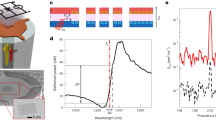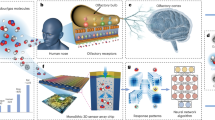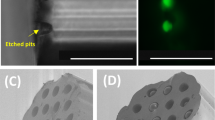Abstract
THE vertebrate olfactory system has long been recognized for its extraordinary sensitivity and selectivity for odours. Chemical sensors have been developed recently that are based on analogous distributed sensing properties1–4, but although an association between artificial devices and the olfactory system has been made explicit in some previous studies4,5, none has incorporated comparable mechanisms into the mode of detection. Here we describe a multi-analyte fibre-optic sensor modelled directly on the olfactory system, in the sense that complex, time-dependent signals from an array of sensors provide a 'signature' of each analyte. In our system, polymer-immobilized dye molecules on the fibre tips give different fluorescent response patterns (including spectral shifts, intensity changes, spectral shape variations6 and temporal responses) on exposure to organic vapours, depending on the physical and chemical nature (for example, polarity, shape and size) of both the vapour and the polymer. We use video images of temporal responses of the multi-fibre tip as the input signals to train a neural network for vapour recognition. The system is able to identify individual vapours at different concentrations with great accuracy. 'Artificial noses' such as this should have wide potential application, most notably in environmental and medical monitoring.
This is a preview of subscription content, access via your institution
Access options
Subscribe to this journal
Receive 51 print issues and online access
$199.00 per year
only $3.90 per issue
Buy this article
- Purchase on Springer Link
- Instant access to full article PDF
Prices may be subject to local taxes which are calculated during checkout
Similar content being viewed by others
References
Gardner, J. W. & Bartlett, P. N. Sensors Actuators B18–19, 211–220 (1994).
Rose-Pehrsson, S. L., Grate, J. W., Ballantine, D. S. & Jurs, P. Analyt. Chem. 60, 2801–2811 (1988).
Carey, W., Beebe, K. R. & Kowalski, B. R. Anatyt. Chem. 59, 1529–1534 (1987).
Hatfield, J., Neaves, P., Hicks, P., Persaud, K. & Travers, P. Sensors Actuators B18–19, 221–228 (1994).
Persaud, K. & Dodd, G. Nature 299, 352–355 (1982).
Lakowicz, J. R. Principles of Fluorescence Spectroscopy (Plenum, New York, 1982).
Kauer, J. S. Trends Neurosci. 14, 79–85 (1991).
Grate, J. & Klusty, M. Analyt. Chem. 63, 1719–1727 (1991).
Zellers, E., Batterman, S., Han, M. & Patrash, S. Analyt. Chem. 67, 1092–1106 (1995).
Stetter, J., Jurs, P. & Rose, S. Analyt. Chem. 58, 860–866 (1986).
Freund, M. & Lewis, N. Proc. natn. Acad. Sci. U.S.A. 92, 2652–2656 (1995).
Carey, W., Beebe, K. & Kowalski, B. Analyt. Chem. 60, 2801–2811 (1988).
Thundat, T., Chen, G., Warmack, R., Allison, D. & Wachter, E. Analyt. Chem. 67, 519–521 (1995).
Barnard, S., Walt, D. R. Envir. Sci. Technol. 25, 1301–1304 (1991).
Lundstrom, I. et al. Nature 352, 47–50 (1991).
Posch, H., Wolfbeis, O. & Pusterhofer, J. Talanta 35, 89–94 (1988).
Orellana, G., Gomez-Carneros, A., de Dios, C., Garcia-Martinez, A. & Moreno-Bondi, M. Analyt. Chem. 67, 2231–2238 (1995).
Sardzewski, R. Talanta 35, 95–101 (1988).
Ronot, C., Archenault, M., Gagnaire, H. & Goure, J. Sensors Actuators B11, 375–381 (1993).
Ruvinov, S., Yang, X.-J. & Sackett, D. J. biol. Chem. 270, 6357 (1995).
Greenspan, P. & Lou, P. Int. J. Biochem. 25, 987 (1993).
Daban, J.-R., Samso, M. & Bartolome, S. Analyt. Biochem. 199, 162 (1991).
Deye, J. F., Berger, T. A. & Anderson, A. G. Analyt. Chem. 62, 615–622 (1990).
Vauthey, E. Chem. Phys. Lett. 216, 530 (1993).
Revial, M., Sicard, G., Duchamp, A. & Holley, A. Chem. Senses 7, 175–190 (1982).
Hamilton, K. A. & Kauer, J. S. J. Neurophysiol. 62, 609–625 (1989).
Meredith, M. & Moulton, D. G. J. gen. Physiol. 71, 615–643 (1978).
White, J., Kauer, J. S., Dickinson, T. A. & Walt, D. R. Analyt. Chem. 68, 2191–2202 (1996).
Kauer, J., Shepherd, G. Physiol. 272, 495–516 (1977).
Zell, A. et al. Stuttgart Neural Network Simulator , User manual Version 3.2 (Rep. No. 6/94, Computer Sci Dept, Univ. Stuttgart, 1994).
Hildebrand, J. G. Proc. Natl Acad. Sci. USA 92, 67–74 (1995).
Author information
Authors and Affiliations
Rights and permissions
About this article
Cite this article
Dickinson, T., White, J., Kauer, J. et al. A chemical-detecting system based on a cross-reactive optical sensor array. Nature 382, 697–700 (1996). https://doi.org/10.1038/382697a0
Received:
Accepted:
Issue Date:
DOI: https://doi.org/10.1038/382697a0
Comments
By submitting a comment you agree to abide by our Terms and Community Guidelines. If you find something abusive or that does not comply with our terms or guidelines please flag it as inappropriate.



